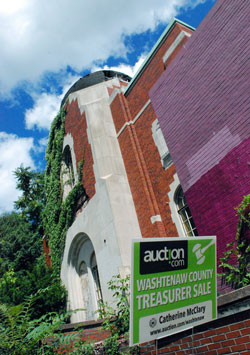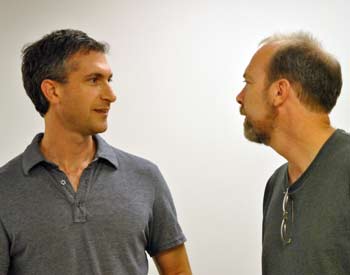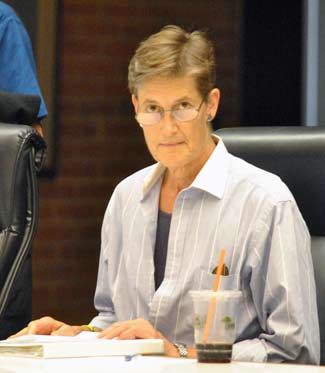Rezoning Process for N. Main Site on Agenda
Several additions to the Ann Arbor city council’s Aug. 20 meeting agenda came on Friday, after the initial Wednesday publication.

Former St. Nicholas Church at 414 N. Main in downtown Ann Arbor. It will be offered at public auction on Sept. 6.
And two of those items involve city ownership of land parcels – at opposite edges of downtown Ann Arbor. One of the properties is already owned by the city of Ann Arbor – the parcel at 350 S. Fifth. Situated on the southern edge of downtown, it’s also known as the Fifth and William parking lot (because it’s currently used as a surface parking lot in the city’s public parking system) or the Old Y Lot (because it’s the location of the former YMCA building).
The resolution would direct the city administrator to evaluate the parcel for possible public or corporate use; and if none is found, to report back to the city council with a timeline for the disposition of the property – based on state and city laws and policies. The resolution, sponsored by Stephen Kunselman (Ward 3), is somewhat unlikely to gain much traction with the council. That’s because it explicitly indicates that the city administrator’s efforts are to be independent of the Ann Arbor Downtown Development Authority’s Connecting William Street planning effort, which includes the 350 S. Fifth parcel.
The Connecting William Street project was undertaken by the DDA based on a directive from the city council, on a unanimous vote, given at its April 4, 2011 meeting. Kunselman voted for that planning effort to take place – but was also vocal at the time, as well as before, about his view that the Old Y lot should simply be put up for sale one way or another.
A second piece of property on the council’s Aug. 20 agenda is located on the northern edge of downtown at 414 N. Main St., near Beakes Street – the site of the old St. Nicholas Church. In 2006, owners of the site received approval for a planned unit development (PUD) zoning designation from the city council. The PUD would allow construction of The Gallery, an 11-story building (158 feet tall) that would include 224 parking spaces and 123 units of residential housing, 18 of which would meet the definition of affordable housing derived by a formula based on area median incomes.
That 414 N. Main property does not belong to the city. But the result of a foreclosure process has put it in the hands of another public entity – the Washtenaw County treasurer’s office. It’s being offered at public auction (on auction.com) starting Sept. 6 through Sept. 11, at a price of $365,051. County treasurer Catherine McClary told The Chronicle in a phone interview that the price includes the demolition costs – and that she’s selected a demolition firm to start the work. Asbestos abatement is already underway, and the demolition itself is expected to begin before the auction, though it will likely not be complete by then, as it will take 15 days.
What would the council’s resolution on the 414 N. Main property actually do? It would start the process to change the PUD zoning to that of the surrounding property, which is D2 (downtown interface) – allowing a maximum building height of 60 feet. The resolution, also sponsored by Kunselman, gives as part of its rationale the fact that the original developer is no longer pursuing the project.
If the property doesn’t sell at the Sept. 6 auction, it will be offered at a second auction. If it doesn’t sell at the second auction, the property would revert to the city. The city could exercise a right of first refusal and acquire the property for the minimum $365,051 bid – but that would require the city to make the purchase for a “public purpose.”
After the jump, we provide a bit more detail on the 414 N. Main property. [Full Story]









